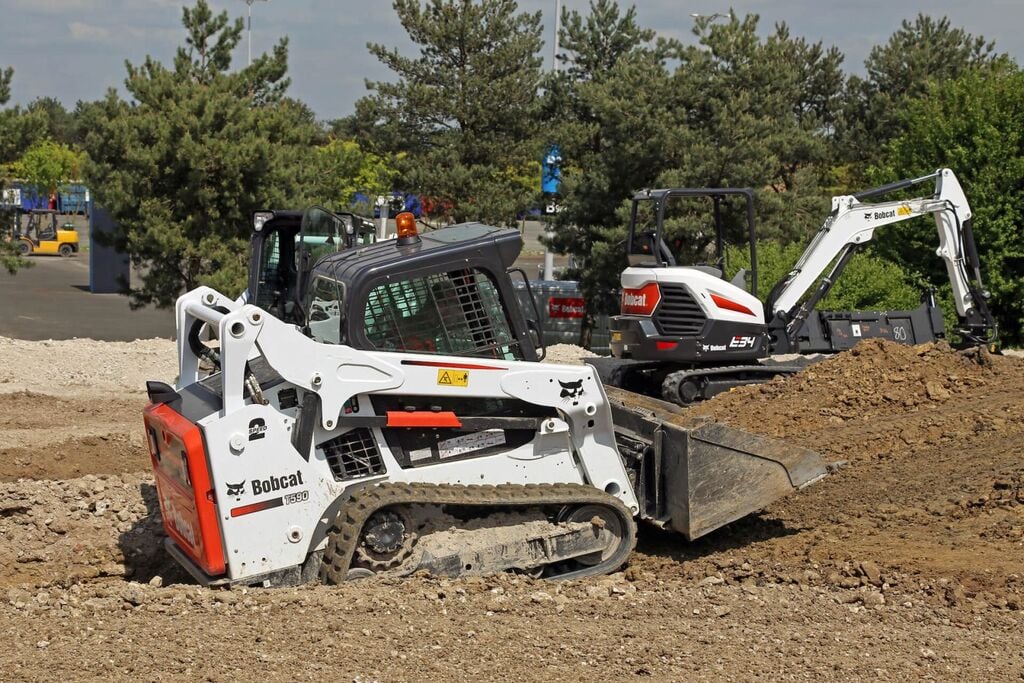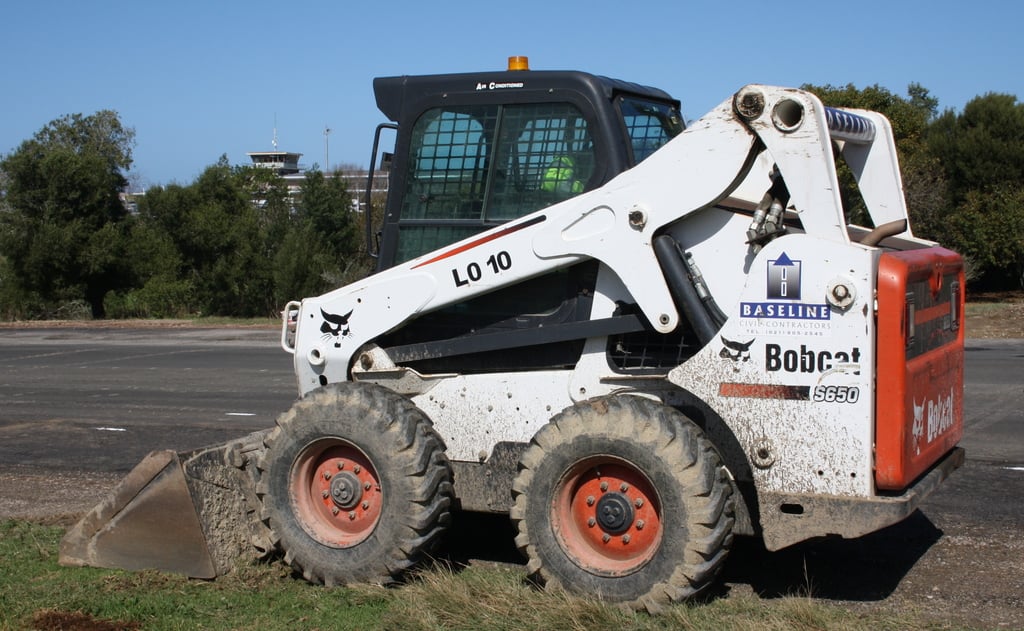To operate a skid steer Bobcat, start the engine, then use the joystick controls to steer and manage attachments. Ensure safety measures are in place before operating the equipment.
Operating a skid steer Bobcat requires familiarity with its controls and functionalities. Before you begin, getting proper training on handling this compact but powerful machine is advisable.
The Bobcat is versatile, serving various construction, landscaping, and agricultural needs, but mastery of its operation is crucial for efficiency and safety.
The operator’s cabin, typically equipped with hand and foot controls, serves as the command center. Engaging the parking brake, adjusting the seat and mirrors, and fastening the seatbelt are preliminary steps you should never skip.
A clear understanding of the job at hand and the terrain will dictate how you navigate and utilize the attachments, showing that competence with a skid steer Bobcat is an amalgamation of preparation, awareness, and skill.
Getting Started with the Skid Steer Bobcat
Skid steer loader Bobcats are compact and agile machines. They can perform a variety of tasks in construction and landscaping. Operators should know the basics before starting. Here’s how to get going:
1. Safety First
Safety is crucial with heavy equipment like the Bobcat. The following key steps ensure a secure operation:
- Wear appropriate gear: Hard hats, safety glasses, and steel-toed boots are a must.
- Inspect the machine: Check for any damage or issues before use.
- Read the manual: Understand safety features and procedures.
- Secure the area: Make sure the work zone is clear of people and obstacles.
2. Understanding the Controls
Knowing the Bobcat’s controls is essential. They might look complex, but they’re easy to learn:
- Buckle up: Use the seatbelt before touching anything else.
- Joysticks: These control the movement and the bucket.
- Foot pedals: They can manage the machine’s attachments.
- Dashboard: It shows vital information about the Bobcat.
Practice with the controls while the Bobcat is off. Develop a feel for the machine’s layout. Users gain confidence and ensure smooth operation.
Operating the Skid Steer Bobcat

Mastering the controls of a Skid Steer Bobcat transforms tough tasks into simple chores. Whether handling construction debris, landscaping or clearing snow, knowing how to operate this equipment safely and efficiently is crucial.
Let’s dive into the essential steps to running a Skid Steer Bobcat like a pro.
1. Starting the Engine
Before starting, conduct a pre-operation inspection. Check the machine, looking for visible damage, leaks, or loose parts.
Ensure that the area is clear and that you have complete visibility. Climb into the cab, secure the safety belt, and lower the safety bar.
Follow these steps to ignite the engine:
- Turn the key to the ‘on’ position to activate the machine’s electrical systems.
- Glance over the control panel for warning lights or messages.
- Push the safety press button, usually located on the left.
- Rotate the key further to start the engine while holding the safety button.
2. Basic Maneuvering Techniques
Controlling a Skid Steer Bobcat is unique due to its skid steering mechanism. The machine turns by speeding up the wheels on one side while slowing down those on the other.
Practice these maneuvers in an open space:
- Pull the levers or joysticks to move forward or reverse.
- Press the left lever or joystick forward to pivot right.
- Push the right lever or joystick forward to pivot left.
- Apply gentle pressure to the controls for smooth navigation.
3. Using Attachments
Attachments enhance the versatility of your Skid Steer Bobcat. From buckets to augers, each attachment demands specific handling:
| Attachment | Operation |
| Bucket | Use the control stick buttons to lower, tilt, or dump the load. |
| Forks | Approach loads evenly, then lift using the vertical control. |
| Auger | Guide into position, then drill using the auxiliary hydraulics. |
Remember to read the manual for each attachment for specific instructions. With practice, changing and using different attachments becomes a swift and effortless process.
Safety Tips And Best Practices

Using a skid steer Bobcat isn’t just about getting the job done. It’s critical to work safely and effectively.
From checking the machine to handling various terrains and managing loads, following these tips will help ensure heavy equipment operator safety and machine longevity.
1. Inspecting The Machine
Before operating, carry out a thorough inspection. This can prevent accidents and machine damage.
- Check tire pressure and tread wear
- Examine hydraulic hoses and fittings for leaks
- Ensure all lights and signals are functional
- Verify that the bucket or other attachments are securely fastened
2. Operating On Different Terrains
Navigating varied terrains calls for adaptability and caution. Here’s how to stay safe:
- On slopes, keep the heavy end uphill to maintain stability
- Avoid sharp turns on inclines to prevent tipping
- Adjust speed according to surface conditions
- Stay clear of unstable ground to prevent accidents
3. Loading And Unloading
Correct loading and unloading practices are essential. Follow these steps for a smooth process:
| Step | Action |
| 1 | Secure the skid steer Bobcat on the trailer with chains |
| 2 | Ensure ramps are stable and clear of debris |
| 3 | Drive slowly up or down the ramps to avoid skidding |
Maintenance And Care

Keeping your skid steer Bobcat in top condition is essential for performance and longevity. Proper maintenance and care mean fewer breakdowns and a longer life for your machine. Follow these steps to keep your skid steer running smoothly.
1. Regular Inspections
Regular inspections prevent unexpected problems. Start with a visual check each day before use. Look for any signs of wear or damage. Make sure to check the following:
- Hydraulic hoses and fittings for leaks
- Tires for proper inflation and cuts
- Attachments for correct operation
- Engine oil and coolant levels
Refer to the operator’s manual for a complete checklist and inspection frequency.
2. Cleaning And Lubrication
Keeping your Bobcat clean prevents dirt buildup that can damage its parts.
After each use, do the following:
- Remove debris from the cabin, tracks, and attachments.
- Wash the machine to prevent rust and corrosion.
- Apply lubricant to moving parts to reduce friction.
Lubricate joints and bearings as specified in the manual for optimal performance.
3. Storage Tips
Proper storage protects your skid steer Bobcat from the elements.
Follow these steps:
- Store in a clean, dry space.
- Disconnect the battery if not in use for extended periods.
- Cover the exhaust and intake to keep pests out.
Before storing, check fluids and fill up the fuel tank to prevent moisture inside the tank.
Advanced Techniques And Considerations

Mastering the operation of a Skid Steer Bobcat requires practice and skill. Once you are comfortable with the basics, you can move on to more advanced maneuvers and handling techniques.
Now let’s dive into expert advice for precision handling, working in tight areas, and managing different load types effectively.
1. Precision Handling
Seamlessly maneuver your Skid Steer Bobcat with these pointers for precision handling:
- Throttle Control: Adjust the throttle gradually; smooth inputs lead to fluid motion.
- Steering Techniques: Apply slight movements for straight lines or sharp turns.
- Attachment Mastery: Understand your attachment limits to enhance control.
2. Working In Confined Spaces
Finesse is key when navigating through cramped environments. Tips include:
- Scout the space first: Ensure enough room for the machine and load.
- Plan movements: Visualize paths to prevent jams or damage.
- Go slow: Movements should be deliberate and measured.
3. Adjusting For Various Loads
Skid Steer Bobcats can handle diverse loads, but adjustments are crucial:
| Load Type | Adjustment | Tip |
| Heavy | Lower your speed | Keep the load low to maintain stability |
| Unbalanced | Steady & slow movements | Secure the load whenever possible |
| Liquid | Smooth acceleration and deceleration | Use a specially designed bucket |
Quick And Easy Steps To Learn How To Drive A Bobcat

Mastering the controls of a skid steer Bobcat can seem daunting, but it’s simpler than you might think. With these straightforward steps, you’ll be navigating like a pro in no time.
Here’s how to confidently start, operate, and turn off a Bobcat, with a strong emphasis on safety every step of the way.
1. Starting The Bobcat
Beginning your Bobcat adventure starts with understanding the startup process. To ignite the engine:
- Find a comfortable position in the operator’s seat.
- Ensure the safety bar is in place and locked.
- Check that all controls are in neutral.
- Turn the key to start the engine.
2. Operating The Bobcat
Operating the Bobcat is intuitive once you get the hang of the controls. Use this guide to maneuver:
- Push both levers forward to move forward.
- Pull both levers back to reverse.
- Control the arm and bucket with the foot pedals.
- Always keep your eyes on the path and surroundings.
3. Turning Off The Bobcat
Wrapping up your work requires a safe shutdown of the Bobcat.
- Return the Bobcat to a flat, level surface.
- Bring all controls to neutral.
- Lower the bucket to the ground.
- Turn the key to the off position and remove it.
4. Safety When Operating The Bobcat
Safety is paramount when operating heavy machinery like a Bobcat. Follow these tips to ensure a secure operation:
- Wear appropriate safety gear, including a helmet and seatbelt.
- Check the Bobcat for any maintenance issues before starting.
- Avoid operating on steep inclines to prevent tipping over.
- Be aware of bystanders and maintain a safe working area.
Frequently Asked Questions
A skid steer Bobcat is a versatile machine used for digging, lifting and loading materials. It’s often found on construction sites, in landscaping, and for snow removal. Its compact size allows operation in tight spaces.
To start a skid steer Bobcat, first ensure the area is clear. Sit in the operator’s seat, fasten the safety belt, and lower the safety bar. Then, according to your specific model, turn the ignition key or press the start button.
Before operating, always conduct a pre-operation inspection. Wear seat belts, keep limbs inside the cab, and be mindful of your surroundings. Never exceed the machine’s operating capacity and follow all manufacturer’s safety guidelines.
Yes, you can change attachments on a skid steer. Turn off the engine, release hydraulic pressure, and follow the quick-connect system’s protocol to swap out tools like buckets, forks, or snow blowers.
Conclusion
Mastering a skid steer Bobcat requires practice and attention to safety. By following the steps outlined, operators can ensure efficient and secure handling.
Remember, routine maintenance is key to performance. Embrace these tips for a confident, successful operation. Drive, dig, and develop your skills—with safety at the helm, success follows.
In Case You Missed It!

